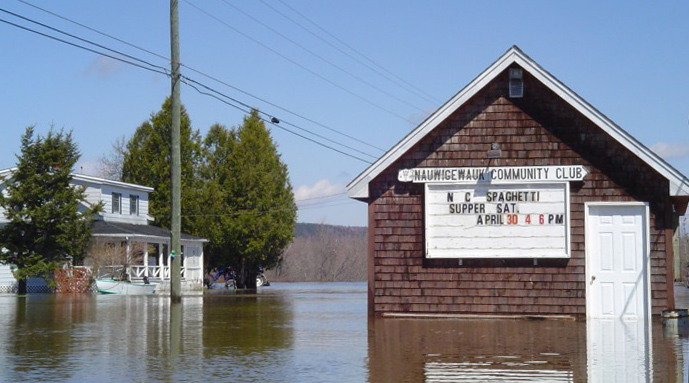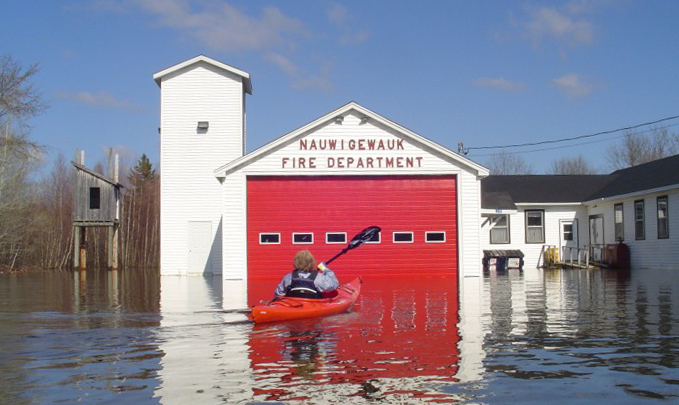
17 government inspectors, 170 companies and more than 9,000 potential infractions: inside B.C.’s oversight of the oil and gas sector
Notes made by regulator officers during thousands of inspections that were marked in compliance with...
There are no buildings left on the road to Darlings Island, a low-lying strip of asphalt that curves gently along the Hammond River in southern New Brunswick. The demolition crews may have knocked them down, but it was the floods that did them in.
In the aftermath of another spring of extreme flooding in Atlantic Canada, few places have been as physically changed as this roadway in Nauwigewauk, a rural community on the front lines of Canada’s changing climate.
“It looks like a nuclear blast site,” Paul Thompson, a retired firefighter who was one of the residents who lost their homes, told The Narwhal.
Where his house once stood, there’s a pile of gravel, surrounded by debris left behind when the water receded. His neighbours’ homes are gone, too. Most notably, the volunteer fire hall across the road and the Nauwigewauk Community Centre — a local social hub that had hosted countless kindergarten classes, dances, variety shows, Halloween parties, Beaver Scouts meetings and strawberry-shortcake socials since 1948 — have also been demolished.

A Nauwigewauk Community Club building underwater during flooding in 2018 in New Brunswick. Photo: Nauwigewauk Community Club
After back-to-back historic floods along the St. John River watershed, this community and others like it in New Brunswick are being redrawn by backhoes, demolition equipment and government officials — who are now enforcing flood-plain building restrictions that went ignored for decades.
In Thompson’s case, the province bought his house, which he’d spent years building up to withstand floods, and sold it to the highest bidder for $5,000 — provided they moved it to higher ground. In its place, there are plans for a new road that would be raised 1.5 metres above the existing road.
People in the province are talking about climate change in a way they never would have a few years ago. For the second straight year, hundreds of homes were evacuated and long stretches of the Trans-Canada Highway were underwater. Even officials who manage flood response seemed surprised at the level of destruction this spring.
Many in the province say New Brunswick needs to start making hard choices about how to adapt.
“The world is changing. I see it every year,” Taya Wallace, president of the Nauwigewauk Community Club, told The Narwhal. “You see how it’s affecting things. It’s right in front of us here.”
In May, Wallace and her neighbours watched as heavy equipment knocked down their community centre. It was an emotional moment for some, including Wallace, who had her wedding reception and many family reunions there.

The Nauwigewauk Community Club hall was demolished in May 2019 after back-to-back historic floods. Photo: Catherine White / Oak Lawn Images
The decision to demolish the hall was made prior to this spring’s flooding that once again left the building half-submerged — something that only confirmed it was the right choice.
“It was devastating,” she said. “But we didn’t really have a choice.”
The building’s fate was sealed the previous spring, when Wallace watched as the river rose higher and higher over the covered bridge by her house. That wooden span, the postcard-esque entryway to Darlings Island since 1914, has long been a measuring stick for the annual spring thaw.
The last time the river was that swollen, Pierre Trudeau was in his second term as prime minister. Residents had to strap the historic bridge down to keep it from floating away. More than 45 years later, Trudeau’s son was calling that kind of extreme weather “the new reality.”
Residents on Darlings Island have grown used to becoming stranded from the mainland for days, their road vanishing under flood waters. When Wallace’s husband arrived by boat to report the community centre was also under water, she sensed that something serious — and unprecedented — was happening to her community.
“I remember Brent coming home and saying, ‘The flood, it’s in the hall, and it’s not even peaked yet,’ ” she said. “I just had this overwhelming feeling that we were up against something we’d never dealt with before.”
New Brunswick, with its sprawling network of rivers, wetlands and low-lying communities, is grappling with an increasingly expensive flooding problem. The Insurance Bureau of Canada says flood claims paid out by insurance companies in New Brunswick grew from $59 million in 1996 to $144.3 million in 2015. That’s larger than the average annual flood payout for all of Canada between 1990 and the early 2000s.
For people who live in the province’s flood-prone communities, climate change has sparked a debate over costly mitigation projects, such as diverting water channels, building dikes or raising highways. Premier Blaine Higgs, a vocal opponent of the federal carbon tax, believes permanent fixes are needed — fixes like changes to building patterns and regulations around how close people can build to rivers.
Some argue the federal government should require homeowners move out of areas with repeated floods if they want to receive disaster relief funding. Critics say New Brunswick needs to become more proactive when it comes to climate change, instead of reacting once disasters hit.

Nauwigewauk flooding in 2018, New Brunswick. Photo: Nauwigewauk Community Club
The floods are only expected to get worse. The province’s legislative committee on climate change has computer models that predict New Brunswick’s average annual temperature could increase by as much as five degrees within 80 years. That means more intense rain and snowfalls, exacerbating the spring runoff.
Some residents are choosing to adjust the way they live, raising their homes up above high water marks. Others are simply leaving. In some rural communities, volunteer fire departments are offering to torch flood-ravaged properties to save on demolition costs.
Thompson believes homeowners should be allowed to build in flood plains, as long as they’re prepared for recurring flood waters. He believes the government’s response to chronic flooding, by expanding restrictions on building near water, is an over-reaction.
“Common sense has to prevail,” he said. “Look at Vancouver. They have houses on piers. Down in Louisiana, they have houses on piers. Our house was built on concrete, with blocks all around it. We felt we were protected.”
Nauwigewauk has always existed on a floodplain, but the severity and frequency of the flooding here is literally reshaping the community. Flooding that used to happen every few decades has become an annual event. That concern, for future floods, was a big factor in the decision to demolish the community hall.
“We moved here in 1974, and for 30 years we never had a problem. The last ten years, we’ve had water pretty much every year,” Nancy Thorpe, a Darlings Island resident and longtime volunteer with the community club, told The Narwhal.
“There were quite a few people who thought we could save the hall, and continue. But there was so much we had to mitigate and do to handle the next flood. Here was two years in a row,” Thorpe said.
“Whatever we would have done last year, we would have to do again this year.”
Thorpe points out life was already changing in Nauwigewauk long before the flooding. It’s been harder and harder to get volunteers for community events, and the club’s directors were already pondering a future without their landmark hall. But the flooding forced their hand.
In a province where one out of every six homes is built in a flood-prone area, thousands of homes and businesses have been affected.
As the waters receded from the recent floods, the New Brunswick Emergency Measures Organization warned cleanup efforts could be hampered by contaminated water that posed serious health risks. From plunging property values to depleted disaster-relief programs, the economic impact is significant.
“I feel bad for people who can’t sell their homes because of all the flooding,” Catherine White, who has lived on Darlings Island for 48 years, told The Narwhal.
“It’s just one of the things with where we live… When the flooding starts, you have to decide if you’re going to stock up on groceries and stay, or you find somewhere to live off the island for a while.”
Chronic flooding has people paying more attention to sudden flips in the weather here, such as some wild swings seen last April when the temperature soared from snowstorms to 26 C in a matter of days.
The rising waters can’t entirely be blamed on climate change, but climatologists say higher seasonal temperatures and precipitation certainly increase the risk of flooding. In Nauwigewauk, Darlings Island and many other New Brunswick communities, people say life is already changing, and fast.
“In 2018, everyone said it’s a once-in-a-century flood. It’ll never happen again. And sure enough, it did happen again. The very next spring,” White said.
“If you don’t think global warming is happening now, you’ve got your head buried in the sand.”
*Updated June 18 at 8 a.m.: Nauwigewauk was originally incorrectly spelled as Nauwidgewauk.
Get the inside scoop on The Narwhal’s environment and climate reporting by signing up for our free newsletter. On March 17, federal Conservative Leader Pierre Poilievre...
Continue reading
Notes made by regulator officers during thousands of inspections that were marked in compliance with...

Racing against time, dwindling habitat and warming waters, scientists are trying to give this little-known...

From investigative reporting to stunning photography, we’ve been recognized with four 2024 CAJ Awards nods...
